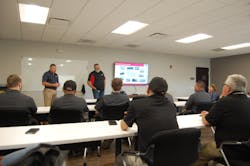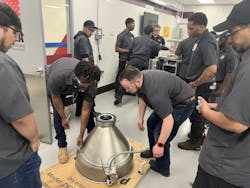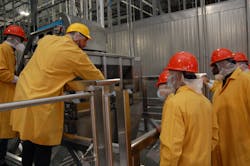With an extreme shortage of available and willing plant floor workers in recent years, many in the food & beverage processing industry have gone “all in” on automation — a completely valid reaction that has produced significant positive outcomes for many.
Yet, food & beverage processing is not a “turn on the machines, shut off the lights and walk away” type of industry. Human intervention remains a necessity, particularly in maintenance, service and repair. That’s where highly skilled technicians come into play.
For the past decade, well before Covid-19, the industry heard the warnings about the shrinking pool of skilled technicians, whether in the processing plants themselves or working for the original equipment manufacturers (OEMs). Recruitment and training were scattershot. Finding skilled technicians interested in the food industry was challenging. Meanwhile, technology kept charging ahead. Something more substantial needed to be done, says David Seckman, president and CEO of the Food Processing Suppliers Assn. (FPSA).
“We need to be able to train technicians and evolve while our industry becomes much more sophisticated, much more advanced through technology,” he explains. “And the industry simply doesn’t have the capacity or ability to train them at the processing plants or the OEM shops, because they are focused on production.”
About five years ago, FPSA (www.fpsa.org) embarked on a plan to help alleviate the issue, with 16 company executives bringing their perspectives on training program needs for field service and maintenance technicians, explains Robert Greaney, quality assurance and curriculum advisor to FPSA’s Food Industry Technician (FIT) Development Program.
“No one was completely satisfied with what they were doing internally or with outside partners,” he says. “Initial meetings and discussions with these executives led to bringing together a larger team that included 30-plus subject matter experts (SMEs) from a cross section of OEMs and food processors.”
Several iterations of discussion led to a high-level curriculum to use as the basis for selecting a primary education partner and development of the FIT program itself, Greaney adds. FIT developed a partnership with the Lincoln Technical Institute’s Indianapolis campus, which recruits students, performs the training and houses the program’s equipment lab.
Five years later, that partnership is flourishing. Lincoln Tech recruits high-performing students from their vocational classes, and FIT molds them into highly skilled, food-processing equipment technicians who go on to work in the industry across the country. In fact, the program has done well enough that in April 2022, FPSA made a significant investment to expand class space and the equipment lab and to hire more instructors, effectively doubling the size of the student body.
FIT offers students a more robust choice, and recruits them accordingly, explains Seckman. When students see what awaits them should they get accepted into FIT, their eyes are opened to possibilities.
“It's kind of a life-changing career opportunity, and they love the idea that the food industry is not going away,” he says. “They see that now, for the first time, they’re starting a career; it’s not going to be just working as a journeyman electrician with a family business and not having other options.”
FIT isn’t a starter program for students off the street. It is designed to elevate skills already mastered in vocational training to match industry needs, and then give graduates access to jobs servicing and maintaining food facilities and equipment.
“We’ve never had anybody who didn’t receive an offer, and the vast majority of students received multiple offers,” Seckman relays. This success rate allows FIT to raise its standards for acceptance, and students entering the program must have received their one-year certification in either electronics or HVAC.
“We want to get the best and the brightest, because it’s a scholarship program,” Seckman says. “So, there are a lot of requirements: You have to agree to relocate and work for a company for at least one year; you have to have at least a 3.0 GPA in your vocational training; and you have to have at least two recommendations from your instructors.”
Core vocational training, which includes book work and hands-on training, can take 11-18 months at Lincoln Tech campuses, depending whether the student has targeted a certificate or associate’s degree. That training sets a foundation for FIT to build upon, Greaney says.
“The reality, however, is that working on today’s food processing equipment or working in the facilities maintenance area requires a much broader skill set,” he explains. “Safety, blueprint reading, maintenance tools, troubleshooting, fasteners and rigging … are not topics covered in electronics or HVAC vocational training, yet are quite important to the food processing industry.”
Students attaining a very high GPA in their core vocational training, as well as excellent references, move on to being considered for the FIT program. The 12-week program is divided into three “capstones” — four-week segments that follow a logical methodology from the simple to the more complex, focused on industrial maintenance and mechatronics.
FIT instructors aim for 30% of learning done in the classroom setting with the remainder of time spent in the equipment lab completing exercises on actual equipment found in food plants.
“We expose the FIT students to specific lab exercises where they must fully demonstrate their competency,” Greaney says. “For each capstone and chapter in the required text, we can link a skill to a specific trainer or machine, where students will apply their knowledge to demonstrate competencies they have acquired.”
The hands-on experience in the lab starts with Lincoln Tech teaching the discipline and structure that is required in many plants and OEM facilities, Seckman says.
“They teach the students — not just our program, but in others too — certain requirements for showing up on time, for example,” he says. “In fact, that's one of the things we instituted right away when we started the program was, when the students show up, they get fingerprinted every day in the classroom, because that’s the type of requirements they’re going to see in a processing plant.
“We want them to come in uniform as well, to learn that mindset, because that's what their employers are going to have, and it’s also what they need to learn to be successful,” Seckman adds.
Greaney says FPSA member companies have done their part to ensure students are getting as close to real-world training in the equipment lab as is possible, having donated more than 30 pieces of food industry machinery, including metal detectors, vacuum fillers, slicers and devices that convey products.
“Presently the lab includes training simulators for PLCs, VFDs, hydraulics, pneumatics, motors/motor controls and different types of sensors,” he says. “We definitely appreciate the donation of equipment for our lab experiences; some acquisitions we still hope to make include packaging equipment — horizontal and vertical — and those pieces of equipment that have more complex control systems and servo motors.”
Evolving with need
When FPSA opened its membership beyond equipment suppliers to include food processing companies, that kicked FIT into a higher gear, giving the program an even wider opportunity for technicians. In turn, processor members host tours with each FIT class at their plants, giving them the ability to show students what they offer as a potential employer.
“When we talk to the processing plants, we learn even more pieces of information that help us develop the program and make it better, just as we do when we talk to original members,” Seckman says. Visiting plants and working with processors and OEMs make a big difference for the program and the students.
FIT instructors also warn the students that, once they graduate and get a job with an employer, their education doesn’t end.
“We tell the students that once they’re working at the plant, a whole different level of education begins, because those companies have specific training requirements and programs with their equipment, which can vary from company to company,” Seckman says. “We’re just giving them the fundamental aspects of the position they’re accepting as a technician.”
Curriculum refinement has occurred and will likely happen again, Greaney says, as “adult technical education is a complex topic.” FIT administrators face the everyday challenge to keep students up to speed with the fast pace of change around the industry.
“For example, it was originally our belief that we didn’t need hydraulics, and FIT should focus a lot of time on ladder logic,” he explains. “We have since added hydraulics training while somewhat reducing [the time spent] learning to write ladder logic.”
In addition to continually improving the program’s offerings, Seckman states that the plan is to expand FIT moving forward.
“Our plans are to increase the number of students and the locations, because we know that this needs to get a lot larger,” he says. “The more students we can get in the program and the better qualified they are, the bigger the benefit, especially with the sophistication of the equipment growing and demanding better technicians in the industry.”
“We’re talking about a variety of different campuses, different locations throughout the country, to replicate this and do more training than ever, because the need is too big,” he says. As FIT has evolved and grown, the FIT team sees the results as well, Greaney relays.
“It has been a rewarding experience seeing the progress of our graduates, particularly when we tour the plants where they are employed, or when they return as service technicians to teach the next class of FIT students,” he says. “It is interesting to note that at the last Process Expo, a number of FIT graduates were observed manning booths and running various pieces of equipment in the show’s processing lines.”
In five years, the ways in which FIT offers the opportunity to learn and create robust careers, filling a need for processors and OEMs alike, should open the eyes of industry to a unique opportunity and solution.
“The workforce issue is not going away, and to hire people who aren’t trained for a technician job in the food industry is taking a big risk, and a very difficult and expensive proposition,” Seckman says. “So the more qualified employees that we can provide through FIT, who start off at a higher type of level of training and knowledge, the better off we are as an industry.”
As the pool of workers continues to shrink for any type of job in a food processing or equipment manufacturing plant, industry would be well-advised to consider developing a homegrown system to sow and reap the rewards of producing its own labor.





